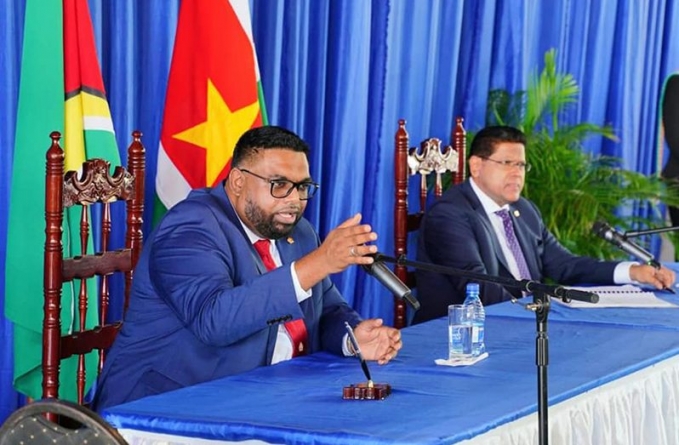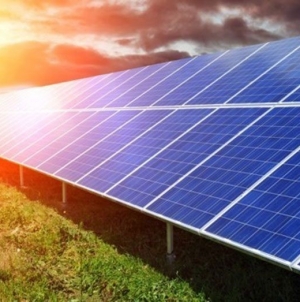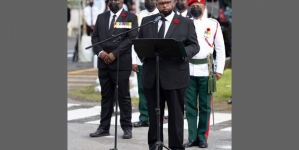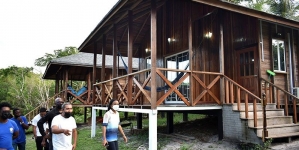Suriname, Guyana border issue will not stop development
PRESIDENT Dr. Irfaan Ali said Guyana and Suriname will focus on advancement, development, integration and good relations as the Joint Commission between Guyana and Suriname mediate the border issue over the New River Triangle territory.
The Head of State made this announcement on Tuesday at a joint press conference held in Paramaribo, Suriname with the Surinamese President, Mr. Chandrikapersad Santokhi.
Focusing on a partnership that will benefit citizens of both countries, President Ali said that while the Commission is doing its work, the focus is to move ahead with strengthening relations between the two countries, and solidifying plans in order to create new opportunities.
“We had a maritime issue that has been resolved, and I am sure you are aware that we have a border commission that is working assiduously on outstanding issues. We have to allow the process to bring a resolution, and both countries are benefitting. We have to allow the Commission to do its work at the technical level, and of course, when they finalise their work, they will bring their recommendations to us,” the President said in response to a question posed by a journalist to him.
The President said the two countries will develop a framework for trade that will be equipped to face the challenges and opportunities in promoting development.
In mid-2011, former Surinamese President Desi Bouterse brought up the border issue, noting that his country would be pursuing actions, based on international law, to explore the possibility of the issue being handled by means of a friendly settlement.
The New River Triangle border issue between Guyana and Suriname dates back to 1840. In 1936, a Mixed Commission established by the British and Dutch Governments agreed to award the full width of the Corentyne River to Suriname, as per the 1799 agreement.
The territorial sea boundary was deemed to prolongate 10 degrees from Point number 61, three miles from the shore. The New River Triangle, however, was completely awarded to Guyana.
The treaty putting this agreement into law was never ratified, because of the outbreak of World War II.
In 1936, the Dutch representative, Conrad Carel Käyser signed an agreement with British and Brazilian representatives, placing the tri-point junction near the source of the Kutari River.
Desiring to put the border issue to rest before British Guiana gained Independence, the British Government restarted negotiations in 1961.
The British position asserted “Dutch sovereignty over the Corentyne River, a 10° line dividing the territorial sea, and British control over the New River Triangle.”
No agreements were made, and Guyana became Independent with its borders unresolved. In 1969, border skirmishes occurred between Guyanese forces and Surinamese militias.
In 1971, the Surinamese and Guyanese Governments agreed in Trinidad to withdraw military forces from the Triangle.
The maritime boundary has long been an issue between Guyana and Suriname, and led, in 2000, to conflict between a CGX oil rig doing work for Guyana and the Surinamese Coast Guard.






















